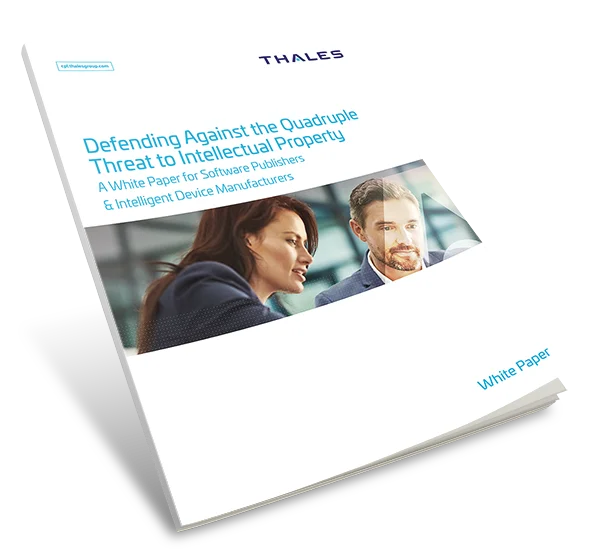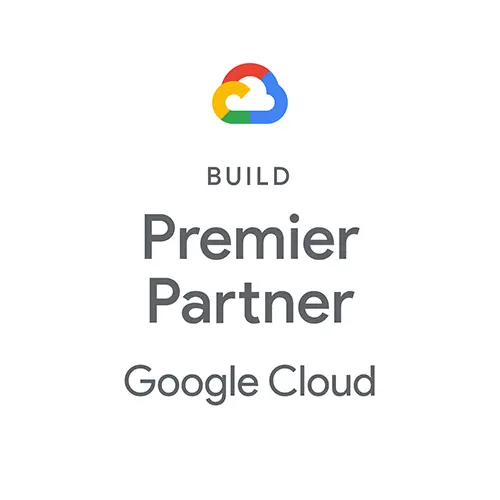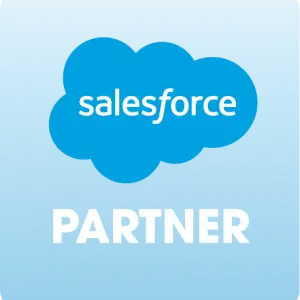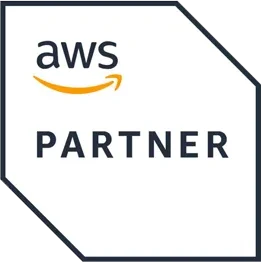What Is Software IP?
Software intellectual property (software IP) is any computer code, program, or application that is protected by law against copying, theft, poisoning, or other use not permitted by the owner. Software IP belongs to the company that either created the software or purchased the rights to it. Unauthorized use by someone else is considered illegal.
Is Software Considered Intellectual Property?
Yes. Any type of intangible property created by the mind, such as inventions, works of art and literature, designs, names, or images can be considered intellectual property. Software fits into this category.
The Four Types of Intellectual Property
Intellectual property law recognizes four types of intellectual property. Let’s look at the four types of IP and how they pertain to protection of software intellectual property.
1) Patents
A patent is the exclusive right to produce, use, and sell an invention. To qualify for a patent, you need to demonstrate that your invention is:
- Novel: No technology like it has yet been produced
- Useful: Your invention provides a clear and reasonably accessible benefit to the user
- Non-obvious: Your invention must have a component of innovation and can’t be the obvious next step in the development of an existing technology
- Patentable subject matter: Different countries have different criteria for what can and cannot be patented
Software patents are extremely valuable for vendors because they can protect aspects of their product that other intellectual property laws cannot. However, they can be difficult to obtain, and the application process is lengthy. Furthermore, different countries have different approaches to the patentability of software.
Example: As part of Apple AI and Machine Learning Research, Apple developed a technology that can make predictions about how a scene could look from different points of view. This technology, called Generative Scene Networks (GSN) is patented by Apple.
You can read more about how to apply for and maintain patents on the United States Patent and Trademark Office website. For more information about filing an international patent that will simultaneously protect your invention in many countries, check out the World International Patent System.
2) Copyright
In contrast to a patent, which protects the idea or concept of an invention, copyright protects the specific expression of that idea. It gives the owner the exclusive right to copy, modify, and distribute or sell those copies or modifications of the property to the public. Copyright is conferred automatically — unlike with patents, there’s no need to go through an application process.
You may be familiar with copyrights that cover marketing materials or logos. Copyrights also cover software elements, such as the specific code used in the program or elements in the user interface. If someone in your company comes up with a unique code or you develop an app, your code or application is automatically protected under copyright law. In other words, software and intellectual property can both be copyrighted. Likewise, data sets that could be used to create or train AI models or tools can be copyrighted.
Example: Salesforce copyrights both their signature marketing characters, and the data of Salesforce and it’s affiliates MuleSoft, Slack, and Tableau.
3) Trade secrets
A trade secret is a process, tool, mechanism, or formula that is not publicly available and is kept secret to maintain an edge over the competition.
Software trade secrets can be protected by law if the owner tries to keep it a secret and no one else has discovered it independently. However legal protection might not stop malicious actors from exposing your trade secrets through reverse engineering. Best practice is to envelop your code in strong protective technology and ensure your protection is hardened and enforced through software licensing after distribution.
Example: The battery cell technology that makes Tesla’s EV batteries perform so well compared to previous EV cars is a trade secret.
4) Trademarks
A trademark is a symbol, phrase, name, or other type of expression used to distinguish a particular product or brand. Names of brands or products are often marked as trademarks using a trademark symbol: ™ for unregistered trademarks, and ® for registered ones.
For software companies, trademarks protect brand identity and ensure customers associate a product with the company that created it. Trademarks do not protect the functionality, design, or technical features of the software itself. Those aspects might fall under copyright or patent protection.
Example: The term AirPods®, which refers to Apple's signature wireless headphones, is trademarked. Hence the encircled R superscript after the name.
What Kind of Intellectual Property is Software?
The software itself — the actual code — is automatically copyrighted. In some cases, it could also be considered a trade secret, and/or could be patented.
The person or company who created the unique software does not need to register for a patent or trademark for its unauthorized use to be considered illegal. Software intellectual property rights could be protected by patent law if the creator has registered for a patent. But just because the IP rights for software are legally protected doesn't mean those rights prevent copying or cracking. Legal protection only gets you so far. Breaking into a house is grounds for arrest, but you still add a lock and alarm system to secure your home. In software too, you need the lock, the key, and the alarm system.
How Does Software IP Protection and Licensing Work?
Software licensing controls the legal and technological aspects of a customer's access to your software. IP protection goes beyond the access control inherent in licensing. It encompasses high-level security capabilities like encryption, tamper detection, and key-disabling. While license control technology is the initial barrier to entry, IP protection and security mechanisms augment licensing and harden security to prevent reverse engineering, piracy, code tampering, and theft of valuable code and IP.
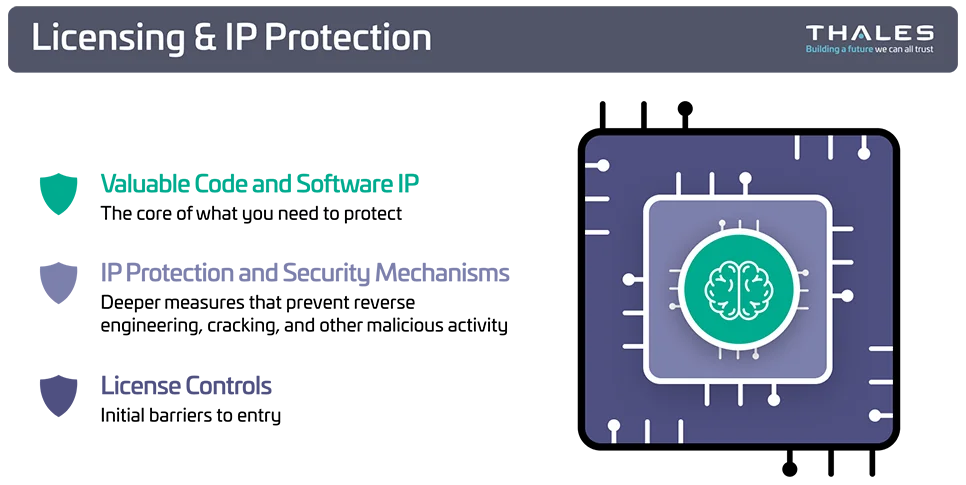
Licensing & IP Protection
Software vendors sometimes assume they don’t need more advanced software IP protection because they think their customers won’t tamper with the software they purchase. While that might be true, it’s risky to rely on goodwill.
As soon as you bring your software to market, no matter how legally protected your IP is, you are exposed. Someone could hack into your product, copy it so they can distribute it illegally and pirate your offering, or reverse engineer your software intellectual property and steal your code or data. The risk varies somewhat by region, but exists globally. AI and machine-learning-enabled functionality add even more risk. AI code that is tampered with or poisoned presents a huge risk to your business and to your users. Therefore, applying tamper-proof IP protection is increasingly recognized as a mission critical task.
IP Protection for AI Models, Agents, and Products
The increasing dependence on AI models across various sectors is exposing vendors to an array of security risks. At the same time, the urgency to innovate and capitalize on AI’s potential has, unfortunately, led many organizations to overlook critical aspects of security, particularly in the domains of data and IP protection.
For vendors utilizing ML models as part of their software offerings, the stakes are especially high. The rapid evolution of AI applications has given rise to new and complex attack vectors, many of which remain unexplored and underestimated. These adversarial attacks target AI models, leading to financial losses, compromised user safety, and loss of competitive edge.
white paper
Defending Against The Quadruple Threat to Intellectual Property
Security is the hardest of all projects that companies try to achieve in-house. This guide is essential reading for software providers who sell applications that run outside their own controlled cloud—whether deployed on-premises, in customer clouds, or on edge devices.
Best Practices for Protecting Software Intellectual Property
A comprehensive security strategy should address legal protections, security during development, software intellectual property protection before and after deployment, and licensing controls to enforce usage terms. Here’s a step-by-step guide to implementing these practices effectively:
1. Establish a Strong Legal Foundation
The first step in protecting your software intellectual property is to ensure your rights are clearly defined and legally enforceable.
- Work with Legal Experts: Collaborate with an experienced IP attorney to identify the appropriate protections for your software.
- Explore Patents: Decide if you want to apply for patents to protect innovative algorithms, processes, or technical implementations.
- Register Trademarks: Protect your brand identity, including your software’s name, logo, and tagline, to build and maintain market recognition.
- Use NDAs for Confidentiality: Require employees, contractors, and partners to sign non-disclosure agreements (NDAs) to protect trade secrets and sensitive information.
2. Secure Your Development Processes
Security starts with how you create and manage your code.
- Secure Development Practices: Use encrypted storage, multi-factor authentication, and controlled access to sensitive repositories.
- Conduct Security Audits: Regularly review your code for vulnerabilities and weaknesses that could expose it to theft or tampering.
- Watermark Your Code: Embed unique, traceable markers to identify and track unauthorized copies if they appear elsewhere.
3. Protect Your Code After Deployment
After deployment, your software is vulnerable, especially on end-user devices or on-premises servers. Ensure your software IP is fully protected against reverse engineering, tampering, copying, and unauthorized access.
- Apply Code Packing: Use dedicated technologies to protect your software code, preventing extraction or modification.
- Encrypt or Obfuscate Core Components: Ensure that critical code and algorithms are encrypted to block visibility of your IP.
- Add Protective Layers: Technologies like app-on-chip execution, fingerprinting, digitally-signed licensing, and quiz mastering further prevent unauthorized access.
- Simulate Attacks: Confirm the effectiveness of your protection measures by creating sandbox environments to test effectiveness.
4. Leverage Licensing to Define Usage Terms and Enforce Restrictions
Licensing serves as both a legal framework and a control mechanism, enabling you to define and enforce how your software is used.
- Draft Clear Licensing Agreements: Specify usage terms, restrictions, and penalties for unauthorized use in a way that aligns with your business goals.
- Offer Flexible Licensing Models: Offer licensing terms that meet customer needs while maintaining strict control over access and usage. When customers can legally purchase products the way they want, they are less likely to try and use your product illegally.
- Ensure Licensing is Enforced: Technological safeguards should back up legal protection. This includes digital license keys that validate usage rights and embedding tamper-proof mechanisms to prevent modification of licensing controls.
How Thales Sentinel Help Prevent Intellectual Property Theft
Given the significant time and investment required to create a technology product, it is a business imperative to protect it from intellectual property theft. Developing strong software IP protection capabilities requires advanced security expertise. To further complicate matters, you need to balance easy access to your product for legitimate users while thwarting hackers and crackers. So, on the one hand, you want to prevent access, and on the other, you want to make access easy.
That’s where Thales’ Sentinel solution comes in. Whether you’re developing software for enterprise applications, IoT devices, or the consumer market, Thales keeps your application secure while supporting your software monetization goals.
Time and again we’ve seen companies attempt to create their own in-house technologies to add software IP protection capabilities and licensing to their offering. This always proves to be expensive, and not just one- –time, but on an ongoing basis. The need to keep security up to date and protect against the latest techniques and technologies never stops.
Our unmatched security tools combined with our industry-leading licensing solutions make it easy for any software vendor to apply the strongest IP protection controls, while ensuring a positive experience for every user.
Contact a specialist today for a personalized assessment of how we can help protect your software intellectual property.
